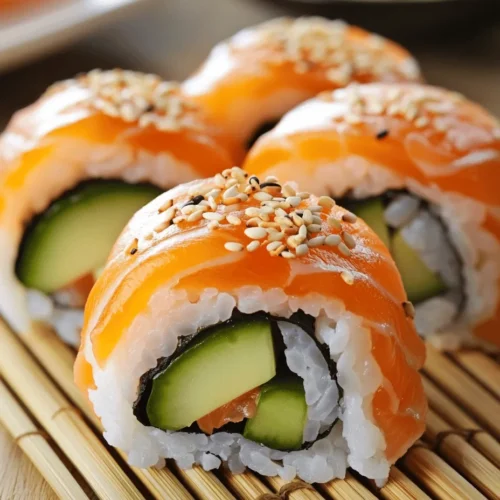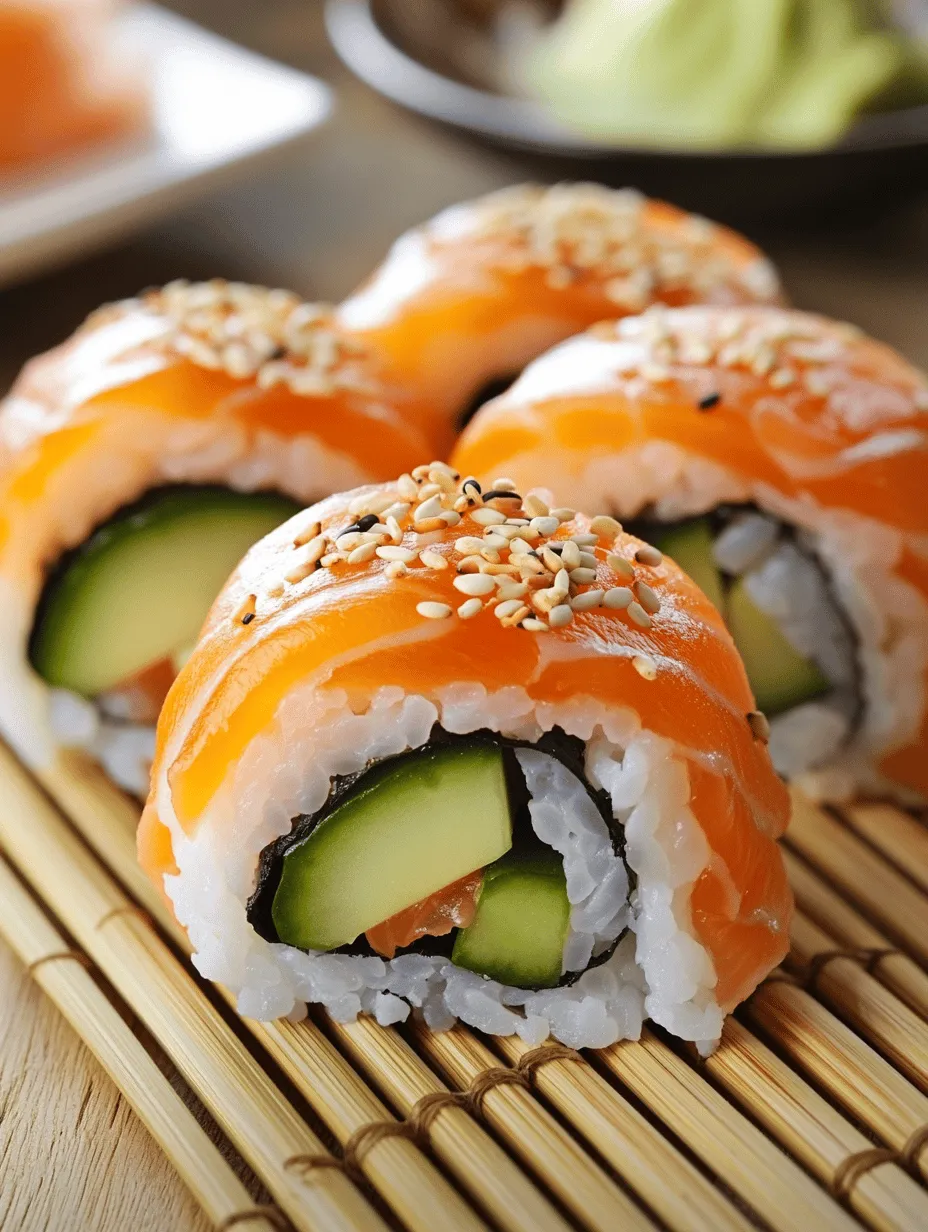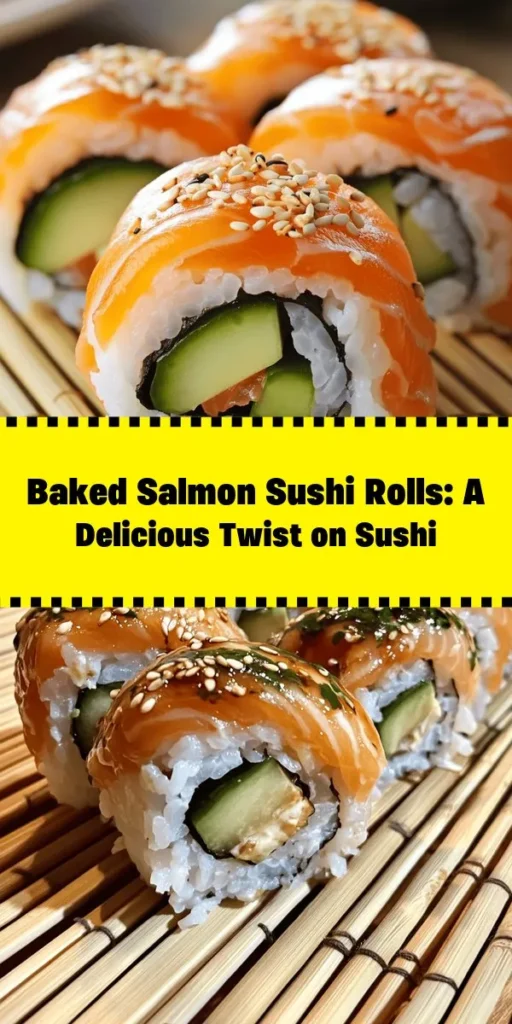Introduction
Sushi, a culinary art form that originated in Japan, has transcended cultural boundaries and become a beloved global cuisine. It captivates taste buds with its delicate balance of flavors and textures, combining vinegared rice with a variety of fresh ingredients. Among the many styles of sushi, baked salmon sushi rolls stand out as a delightful twist on a classic favorite. These rolls offer a unique savory experience that is both comforting and satisfying, perfect for sushi enthusiasts and newcomers alike.
Making sushi at home provides a wonderful opportunity to unleash your creativity in the kitchen. Preparing baked salmon sushi rolls allows you to customize your ingredients, catering to various palates and dietary preferences. Whether you’re hosting a gathering, looking for a fun family activity, or simply craving a delicious meal, these rolls are sure to impress. Plus, the health benefits of salmon combined with fresh vegetables make this dish not only tasty but also nutritious.
Salmon is rich in omega-3 fatty acids, which are essential for heart health and brain function. When paired with vibrant vegetables like avocado and cucumber, baked salmon sushi rolls offer a well-rounded meal that is both satisfying and wholesome. As we dive into the details of this delightful recipe, you will learn about the essential components of sushi, the significance of each ingredient, and how to prepare these delicious rolls right in your own kitchen.
Understanding Sushi and Its Ingredients
To appreciate the beauty of baked salmon sushi rolls, it’s important to understand the fundamentals of sushi itself. Traditional sushi typically consists of three key components: sushi rice, nori, and a variety of fillings. Each element plays a vital role in creating the perfect bite, and understanding them will enhance your sushi-making experience.
The Importance of Sushi Rice
Sushi rice, known as “shari” in Japanese, is the foundation of every sushi roll. Unlike regular rice, sushi rice is specially prepared to achieve a sticky texture that allows it to hold together when rolled. This stickiness is crucial for maintaining the integrity of the sushi roll, ensuring that the ingredients stay securely wrapped within the rice and nori.
To prepare sushi rice, you’ll need short-grain Japanese rice, which is higher in starch content compared to long-grain varieties. The rice is first rinsed under cold water to remove excess starch, then cooked with a precise ratio of water. Once cooked, the rice is seasoned with a mixture of rice vinegar, sugar, and salt, giving it a slight tanginess that beautifully complements the other ingredients. The key to perfect sushi rice lies in its texture: it should be sticky enough to hold together but not overly mushy.
Nori: The Seaweed Wrapper
Nori is the edible seaweed that forms the outer layer of sushi rolls, acting as a wrapper that holds all the delicious ingredients inside. It is typically sold in sheets and comes in various grades; for sushi, it’s best to use high-quality nori that has a dark green color and a slightly glossy finish. The flavor of nori is subtly briny, adding depth to the overall taste of the sushi.
In addition to its flavor, nori offers several nutritional benefits. It is low in calories and packed with essential vitamins and minerals, including iodine, calcium, and vitamin C. The umami flavor of nori enhances the overall experience of sushi, making it a vital component of baked salmon sushi rolls.
The Star Ingredient: Salmon
When it comes to sushi, salmon is one of the most popular and cherished ingredients. Known for its rich flavor and buttery texture, salmon is a favorite choice for both traditional and modern sushi creations. From sushi bars to home kitchens, its versatility allows it to be enjoyed raw or cooked, making it perfect for baked sushi rolls.
One of the standout features of salmon is its impressive health benefits. It is an excellent source of omega-3 fatty acids, which are known to support heart health, reduce inflammation, and promote brain function. Additionally, salmon is packed with high-quality protein, essential vitamins, and minerals, making it a nutritious choice for any meal. When baked, salmon retains its moisture and flavor, resulting in a tender filling that pairs beautifully with the other components of the sushi roll.
Incorporating Fresh Vegetables
While salmon is the star of the show, fresh vegetables play a crucial supporting role in baked salmon sushi rolls. Ingredients like avocado and cucumber not only enhance the flavor profile but also contribute to the overall texture and visual appeal of the rolls.
Avocado, with its creamy texture, adds richness and a hint of nuttiness that complements the savory flavors of the salmon. It is also loaded with healthy fats, vitamins, and minerals, making it a fantastic addition to any sushi roll. Cucumber, on the other hand, provides a refreshing crunch that balances the richness of the avocado and salmon. Its high water content helps to keep the rolls light and hydrating, making them an enjoyable and healthy option.
Preparing Baked Salmon Sushi Rolls
Now that we’ve covered the essential ingredients, let’s dive into the process of preparing baked salmon sushi rolls. This recipe is straightforward and beginner-friendly, making it an excellent choice for those who are new to sushi-making.
Gathering Ingredients for Success
Before you begin, it’s important to gather all the necessary ingredients. Here’s what you’ll need for your baked salmon sushi rolls:
– Sushi Rice: 2 cups of short-grain sushi rice
– Water: 2 ½ cups for cooking rice
– Rice Vinegar: ¼ cup
– Sugar: 2 tablespoons
– Salt: 1 teaspoon
– Nori Sheets: 4-6 sheets (depending on how many rolls you want to make)
– Fresh Salmon: 1 pound (skinless and boneless)
– Avocado: 1 ripe avocado, sliced
– Cucumber: 1 medium cucumber, julienned
– Cream Cheese (optional): 4 ounces, cut into strips
– Soy Sauce: for dipping
– Sesame Seeds: for garnish (optional)
Step-by-Step Instructions
Preparing the Sushi Rice
1. Rinse the Rice: Begin by rinsing the sushi rice under cold water in a fine-mesh strainer. Rinse until the water runs clear, indicating that excess starch has been removed. This step is crucial for achieving the right texture.
2. Cook the Rice: In a medium pot, combine the rinsed rice and 2 ½ cups of water. Bring to a boil over medium heat, then reduce the heat to low, cover, and let simmer for about 18-20 minutes, or until the rice is tender and the water has been absorbed. Once cooked, remove from heat and let it sit, covered, for another 10 minutes.
3. Season the Rice: While the rice is resting, prepare the sushi vinegar by combining the rice vinegar, sugar, and salt in a small saucepan over low heat. Stir until the sugar and salt dissolve. Once the rice has rested, transfer it to a large bowl and gently fold in the vinegar mixture using a spatula. Be careful not to mash the rice; the goal is to keep it fluffy.
4. Cool the Rice: Allow the seasoned sushi rice to cool to room temperature. You can speed up this process by fanning the rice while gently mixing it. The rice is now ready to be used for rolling.
With the sushi rice prepped and ready, you’re on your way to creating delicious baked salmon sushi rolls. Stay tuned for the next steps, where we’ll discuss assembling the rolls and the baking process that brings everything together in a delightful, savory dish.

Rinsing, Cooking, and Cooling the Sushi Rice
The foundation of any great sushi roll is perfectly cooked rice, and achieving the right texture is essential for a satisfying bite. Begin by measuring out your sushi rice—typically, 2 cups is sufficient for making a batch of baked salmon sushi rolls. The first step is to thoroughly rinse the rice under cold water. Place the rice in a fine-mesh strainer or a bowl and run cold water over it while gently swishing the grains with your hand. This process removes excess starch, which can make the rice gummy. Rinse until the water runs clear, usually about 3-4 rinses.
Next, cook the rinsed rice. Transfer the rice to a rice cooker or a heavy-bottomed pot, and add 2 cups of water for every cup of rice. If using a rice cooker, simply follow the manufacturer’s instructions. For stovetop cooking, bring the water to a boil, then lower the heat to a simmer, cover, and cook for about 18-20 minutes. Once the rice has cooked, remove it from the heat and let it sit, covered, for an additional 10 minutes. This resting period allows the rice to finish cooking through steam, achieving that ideal sticky yet fluffy texture.
After resting, spread the rice onto a large baking sheet or a wooden sushi rice tub to cool. This helps dissipate steam and prevents the rice from becoming too wet. Gently fluff the rice with a wooden spatula or rice paddle, being careful not to mash the grains.
Seasoning the Rice
Seasoning is what transforms simple rice into sushi rice. To create the seasoning mix, combine 1/4 cup of rice vinegar, 2 tablespoons of sugar, and 1 teaspoon of salt in a small saucepan. Heat it over low flame just until the sugar and salt dissolve; there’s no need to bring it to a boil. Once dissolved, remove the mixture from heat and let it cool slightly.
Once your rice has cooled to room temperature, you can start folding in the seasoning. Pour the vinegar mixture evenly over the rice, then use a wooden spatula to gently fold the seasoning into the rice. The goal is to coat each grain without crushing it, so use a cutting motion to lift and turn the rice. This step is crucial for flavor and getting the right sticky consistency that holds the rolls together.
Marinating the Salmon
While the rice is cooling and being seasoned, it’s time to marinate the salmon. For this recipe, you will need about 12 ounces of fresh, sushi-grade salmon. Cut the salmon into strips about half an inch in thickness, which will make it easier to layer into your sushi rolls.
In a small bowl, mix together 2 tablespoons of soy sauce, 1 tablespoon of sesame oil, and 1 teaspoon of freshly grated ginger. This combination will not only enhance the flavor of the salmon but also add a lovely aroma. Place the salmon strips in a dish and pour the marinade over them, ensuring each piece is well-coated. Cover and let it marinate in the refrigerator for at least 30 minutes. This step infuses the salmon with rich flavors that complement the other ingredients in your sushi rolls.
Preheating the Oven
Before you start assembling your rolls, it’s important to preheat your oven to 375°F (190°C). The right oven temperature is crucial for baking the sushi rolls evenly and ensuring that the salmon cooks through without drying out or becoming rubbery. A moderate heat allows the salmon to bake gently while the rice warms up and helps meld the flavors together.
Assembling the Rolls
Now it’s time to bring all the elements together. Start by laying a sheet of nori (seaweed) on a bamboo sushi mat or a clean cutting board, shiny side down. If you don’t have a sushi mat, you can use a piece of parchment paper or a clean kitchen towel. Moisten your hands with water to prevent the rice from sticking, then take a handful of seasoned sushi rice and spread it evenly over the nori, leaving about an inch of space at the top edge.
Once the rice is spread out, layer your marinated salmon strips horizontally across the center of the rice. At this point, you can also add other ingredients such as thinly sliced cucumbers, avocado, or cream cheese for added flavor and texture. Be careful not to overfill your roll, as this will make it difficult to seal.
To roll the sushi, lift the edge of the mat or parchment closest to you and start rolling away from you, applying gentle pressure to form a tight roll. Continue to roll until you reach the exposed edge of the nori. To seal the roll, moisten the edge of the nori with a little water, then press down to secure it. With a sharp knife, slice the roll into bite-sized pieces, wiping the knife with a damp cloth between cuts to ensure clean edges.
Baking the Rolls
Place your assembled sushi rolls seam-side down on a baking sheet lined with parchment paper. Bake in the preheated oven for about 15-20 minutes. You’re looking for the salmon to be opaque and flake easily with a fork. The nori will become slightly crisp, adding texture to the rolls. Keep an eye on them to avoid overcooking, as this can dry out the fish.
Serving Suggestions
When your baked salmon sushi rolls are ready, it’s time to present them beautifully. Arrange the rolls on a decorative platter, and serve them with small bowls of soy sauce, pickled ginger, and wasabi on the side. This not only enhances the visual appeal but also allows your guests to customize their sushi experience. For an added touch, sprinkle some sesame seeds or chopped green onions over the top for color and flavor.
Flavor Pairings
Baked salmon sushi rolls can be paired with an array of sauces and toppings to elevate the dish even further. Consider drizzling a spicy mayo sauce made from mayonnaise and Sriracha over the top for a creamy and spicy kick. Alternatively, a teriyaki glaze can add a sweet and savory element that complements the richness of the salmon. Fresh herbs, such as cilantro or microgreens, can also add a fresh burst of flavor, making the dish even more dynamic.
Health Benefits of Baked Salmon Sushi Rolls
Baked salmon sushi rolls are not only delicious but also pack a nutritional punch. Salmon is an excellent source of high-quality protein and omega-3 fatty acids, which are known for their heart health benefits. A typical serving of baked salmon sushi rolls contains around 250-300 calories, depending on the ingredients used. They are also rich in essential vitamins and minerals, including vitamin D, B vitamins, and selenium, which contribute to overall health and well-being.
Balancing Healthy Eating with Enjoyment
Incorporating baked salmon sushi rolls into your diet allows you to enjoy a flavorful and satisfying meal while adhering to healthy eating principles. The balance of protein from the salmon, carbohydrates from the sushi rice, and the fiber from any added vegetables makes this dish well-rounded. You can easily customize your rolls by adding more vegetables or experimenting with different grains like brown rice, making it a versatile option for those looking to maintain a balanced diet without sacrificing taste.
Conclusion
Creating baked salmon sushi rolls at home is an enjoyable and fulfilling culinary experience that combines a variety of delicious flavors and textures. From the perfectly seasoned rice to the succulent marinated salmon, each bite is a testament to the joy of sushi-making. Whether you’re entertaining guests or treating yourself, these rolls are sure to impress. So don your apron, gather your ingredients, and venture into the delightful world of homemade sushi—your taste buds will thank you!



